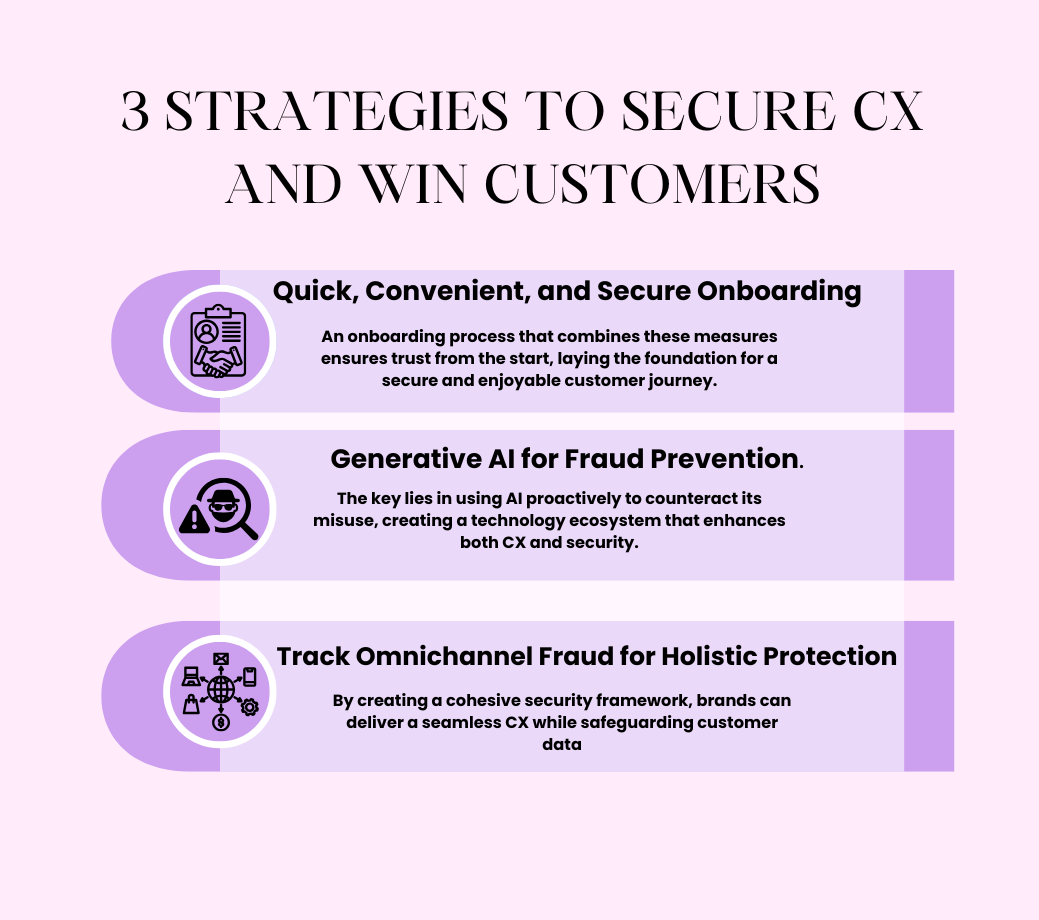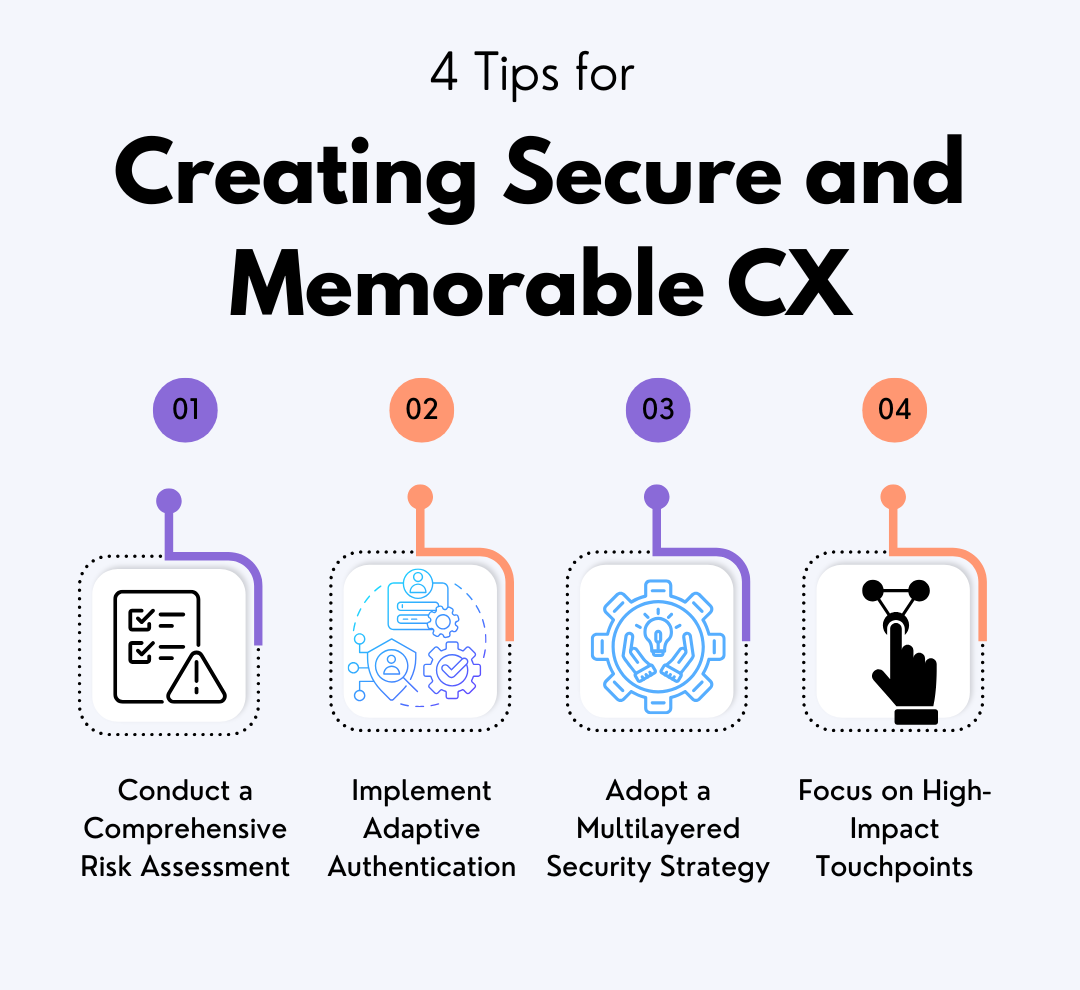Secure CX Strategies to Win Customers in 2025

In a world where consumers expect intuitive, personalized, and secure interactions, CX is a necessity. Research from Forrester underscores this importance, showing that customer-obsessed brands grow revenues 41% faster and achieve profitability 49% sooner than their competitors.
However, not all companies are meeting the mark. Forrester’s latest findings indicate that CX quality in the U.S. is at an all-time low, having declined for three consecutive years. To remain competitive in 2025, brands must balance the fine line between creating seamless customer experiences and implementing robust security measures.
This blog outlines three strategies to achieve secure, seamless, and memorable CX in the evolving digital landscape.
The CX-Security Paradox
Modern consumers are looking for fast-loading platforms, personalized experiences, and secure surroundings to engage with their brands. Yet, as online interactions increase, so does the risk of cyber threats. Balancing streamlined CX with rigorous security protocols is a challenge many brands face.
Concentrating too much on security can make customer journeys cumbersome, creating the risk of fraud against the brands as well as customers due to poor security measures. For example, 83% of CX leaders rate cybersecurity and data protection as top priorities, realizing their roles in keeping the customer journey safe.
In 2025, achieving the ideal balance will require brands to adopt a strategic, three-pronged approach:

1. Quick, Convenient, and Secure Onboarding
Customer onboarding is the gateway to CX. A smooth onboarding process sets the tone for the entire relationship, but it’s also where data vulnerabilities often begin.
The Challenge
While 57% of businesses believe easy onboarding is crucial, 68% of consumers prioritize security over convenience. Rising fraud trends, such as synthetic identity fraud (SIF), have made it clear that streamlining onboarding without strong security measures is a recipe for disaster.
The Solution
Brands can balance convenience and security by:
- Adopting a multi-layered approach to fraud detection: This includes analyzing user behavior, leveraging machine learning, and integrating device-based authentication to detect anomalies in real time.
- Creating custom escalation paths: When suspect identities arise, brands can use adaptive authentication methods, reducing friction for legitimate users while intensifying scrutiny for suspicious accounts.
- Minimizing data collection: Collect only what’s necessary and encrypt sensitive information to ensure compliance with privacy regulations like GDPR and CCPA.
An onboarding process that combines these measures ensures trust from the start, laying the foundation for a secure and enjoyable customer journey.
2. Generative AI for Fraud Prevention
Generative AI, the groundbreaking technology that powers human-like text and deepfake images, is both a boon and a bane for CX. On the one hand, it elevates personalization. On the other, it fuels fraud by enabling threat actors to create sophisticated fake identities and phishing scams.
The Risks
Since the launch of tools like ChatGPT, credential phishing attacks have surged by 967%, with malicious AI-generated content becoming a primary tool for cybercriminals. These attacks undermine customer trust and expose businesses to severe financial losses.
The Opportunities
Generative AI isn’t just a threat—it’s also a defense. Brands can deploy AI for:
- Fraud detection: AI models can analyze user data to detect patterns of fraudulent behavior, flagging potential risks before they escalate.
- Real-time risk assessments: Machine learning algorithms can evaluate user interactions across channels to identify suspicious activities, reducing the window of vulnerability.
- Improved personalization: AI can tailor customer experiences without compromising security, offering users relevant content while ensuring their data remains protected.
The key lies in using AI proactively to counteract its misuse, creating a technology ecosystem that enhances both CX and security.
3. Tracking Omnichannel Fraud for Holistic Protection
Customers interact with brands across multiple touchpoints—from mobile apps to in-store kiosks. While this omnichannel approach enhances CX, it also broadens the attack surface for fraudsters.
The Problem
Mobile and online platforms are prime targets for data breaches, but other channels, such as contact centers and physical locations, are not immune. Fraudsters are adept at transcending channel boundaries and exploiting inconsistencies in security protocols.
The Solution
Brands must adopt a holistic, omnichannel strategy to combat fraud:
- Integrate identity verification across channels: A consistent approach to verifying user identities ensures that no touchpoint becomes a weak link.
- Monitor activity in real-time: AI and ML tools can track user behavior across platforms, detecting anomalies that indicate fraud.
- Educate employees and customers: Awareness campaigns can reduce the likelihood of human error, a common entry point for cyber threats.
By creating a cohesive security framework, brands can deliver a seamless CX while safeguarding customer data.
Creating Secure and Memorable CX
To succeed in 2025, brands must prioritize both security and CX as complementary goals. Here’s how to get started:

1. Conduct a Comprehensive Risk Assessment: Identify vulnerabilities across all customer touchpoints, from mobile apps to physical stores.
2. Implement Adaptive Authentication: Use AI and biometric methods like facial recognition to enhance security without increasing friction.
3. Adopt a Multilayered Security Strategy: Combine encryption, fraud detection, and behavioral analysis to protect sensitive data.
4. Focus on High-Impact Touchpoints: Start with channels that drive the most customer engagement, expanding security measures as needed.
The Business Case for Secure CX
Investing in a secure and seamless customer experience will reduce risk and increase profitability for the brand. According to Forrester's research, such customer-obsessed companies achieve revenue growth and higher profitability faster. Customers will remain loyal to those brands that prioritize their safety and satisfaction.
What Winning Brands Do Differently
- They embrace security as a competitive advantage, not a barrier.
- They leverage emerging technologies like AI to stay ahead of fraud trends.
- They focus on creating personalized, frictionless journeys that protect customer trust.
The Future of CX and Security
As we look to 2025, the convergence of CX and security will define the brands that thrive. Customers expect experiences that are intuitive, personalized, and secure. Meeting these expectations requires a proactive approach that integrates cutting-edge technologies and robust security protocols.
By adopting the strategies outlined here, brands can strike the perfect balance between CX and security, ensuring long-term success in a competitive marketplace. The future belongs to those who prioritize their customers’ needs while safeguarding their trust.
Ready to lead the CX revolution? Subscribe to our website now and start today with seamless security and unforgettable experiences.
FAQs
1. Why is balancing security and customer experience so important?
Balancing security and CX ensures that customers enjoy a streamlined, intuitive experience without compromising their data. Strong security builds trust, while a seamless CX fosters loyalty and satisfaction, both of which drive business success.
2. How can brands ensure secure onboarding without creating friction?
Brands can implement non-intrusive, multilayered security measures like adaptive authentication, biometrics, and behavioral analytics. These tools enhance security while minimizing disruptions for legitimate users during onboarding.
3. What role does generative AI play in CX and security?
Generative AI enhances CX by enabling personalized experiences and real-time risk assessments. At the same time, it helps identify and mitigate advanced fraud tactics, such as synthetic identity fraud and phishing attacks.
4. What is an omnichannel approach to fraud prevention?
An omnichannel approach ensures that fraud detection and security protocols are consistent across all customer touchpoints, including mobile, web, in-person, and contact centers. This minimizes vulnerabilities and protects data integrity across platforms.
5. How can businesses start implementing a secure CX strategy?
Begin with a comprehensive risk assessment to identify vulnerabilities. Implement adaptive authentication techniques, focus on high-impact touchpoints, and adopt AI-driven fraud detection to create a secure and seamless customer experience.




